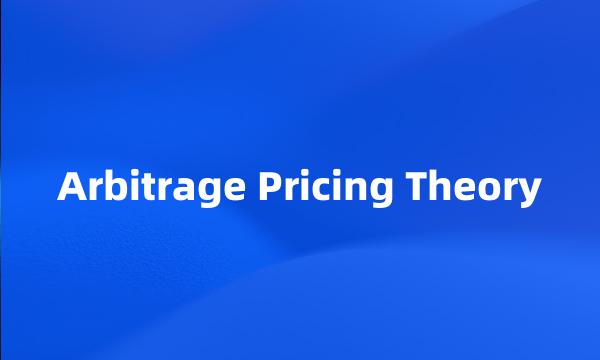Arbitrage Pricing Theory
- 网络套利定价理论;提出了套利定价理论;资本资产套价理论;套 利定价理论
 Arbitrage Pricing Theory
Arbitrage Pricing Theory-
Finally , the mining rights evaluation model based on arbitrage pricing theory has been established through studies of evaluation parameters .
通过对估价参数的研究,构建了基于套利定价理论的采矿权估价模型。
-
Ross proposed arbitrage pricing theory ( APT ), trying to find more suitable for practical pricing models .
Ross提出了套利定价理论(APT),试图找到更适合实际的定价模型。
-
C. Arbitrage Pricing Theory
c.套利定价理论
-
The most important problem in Arbitrage Pricing Theory ( APT ) is how to screen out the factors which need too much computation .
众所周知,建立套利定价模型的关键在于因素的筛选,计算量很大。
-
At last the paper deduces the pricing formula of real option similarly American Option utilizing No-Risk Arbitrage Pricing Theory .
在此基础上,运用无风险套利原则,推导出变动执行价格条件下的类似于美式期权的实物期权的定价公式。
-
By applying the Capital Asset Pricing Theory and Arbitrage Pricing Theory , this paper analyses the problem of profit expectation and risk in securities investment analysis .
从资本资产定价理论和套利定价理论出发,研究了证券投资分析的收益率和风险问题。
-
These traditional economic theory for example efficient market hypothesis and the arbitrage pricing theory , etc , which has been insufficient to explain this complex phenomenon .
IPO抑价现象很复杂,市场有效假说和套利定价理论等这些传统的经济学理论已经不足以解释这一复杂的现象。
-
An Empirical Investigation of APT Model Being Used in Shenzhen Stock Market ; Chapter three analyzes the Arbitrage Pricing Theory ( APT ) of risk assets .
套利定价理论在深圳股市的实证检验第三章分析了风险资产的套利定价理论,对套利定价理论的模型进行了推导。
-
The factors which obviously influenced the stock return in Chinese stock market are researched from using the arbitrage pricing theory ( APT ) and factor model in this paper .
主要运用套利定价理论和建立因素模型研究我国股票回报率及相关因素,为股市的分析提供一个新的工具。
-
In 1976 , Stephen A. Ross developed CAPM and initiated the arbitrage pricing theory ( APT ) which is a breakthrough .
1976年,罗斯(StephenA.Ross)突破性地发展了CAPM,首创套利定价理论(APT)。
-
Next it discusses the methods including arbitrage pricing theory ( APT ), option theory and so on , which improve CAPM based on the analysis of hypothetical conditions thirdly .
再次在分析模型假设条件的基础上,文章讨论了套利定价理论、期权理论等模型的改进方法。
-
The multifactor pricing model is a crucial breakthrough in asset pricing theory and a derivation or an extension of the arbitrage pricing theory ( APT ) .
多因子定价模型(MultifactorPricingModel)是资产定价理论发展到套利定价理论(ArbitragePricingTheory,APT)之后的延伸,是对金融资产定价研究的重要理论突破。
-
The relationship between them was widely studied in many classic assets pricing models , including the Capital Assets Pricing Model ( CAPM ) and the Arbitrage Pricing Theory ( APT ) .
各种资产定价理论,包括资本资产定价理论和套利定价理论探讨的都是它们之间的关系。
-
As a kind of management instrument that can quantify security investment risk , APT ( Arbitrage Pricing Theory ) can be used to measure the price of risky assets when market is in Equilibrium .
套利定价理论(APT)是一种证券投资风险的量化管理工具,是度量市场均衡时风险性基础资产的定价问题的理论。
-
Traditional capital pricing theories price assets based on the hypothesis that market is efficient and investors are rational , thus forms such theories as Modern Portfolio Theory , Capital Asset Pricing Model and Arbitrage Pricing Theory etc.
传统资产定价理论在假定市场有效和投资者理性的基础上对资产及进行定价,形成了最优资产组合模型、资本资产定价模型、套利定价等理论。
-
The basis development status of portfolio theory is summarized . At the same time , the capital market theory and the capital asset pricing model ( CAPM ), as well as the arbitrage pricing theory are carefully analyzed .
综述了投资组合理论发展的基本状况,对资本市场理论、资本资产定价模型以及套利定价理论进行了系统剖析;
-
Through the stochastic discount factor model , it is easy to understand some classical problems of modern finance , such as arbitrage pricing theory and risk neutral pricing , etc. Asset pricing models are unified under the stochastic discount factor frame .
现代金融学的许多经典问题,如套利定价原理以及风险中性定价等都可以用随机折现因子模型理解,随机折现因子模型是资产定价模型的统一框架。
-
Multifactor model assumes that the return on investment will be influenced by various risk factors , when under this model 's assumption , the return and risk reach equilibrium , the Investment return of the risk asset is described by Arbitrage Pricing Theory ( APT ) .
该模型假设投资收益率受到多种风险因素的影响,收益率由各风险因素溢酬的线性组合决定。当多因素模型框架下收益与风险达到均衡时,风险资产价格遵守套利定价理论。
-
Arbitrage Pricing Theory ( APT ) figures that the completely individual movement in asset return should not have any risk prices . The risk price or expected return of one kind of security should only be relative to its common changing factors or covariance of the security .
套利定价理论(APT)认为资产收益中完全个性化的运动不应该有任何的风险价格,一种证券的风险价格或期望收益应该只与该证券的共同变动因素即因子的协方差相关。
-
Afterwards , Capital assets pricing theory of Sharp , Arbitrage Pricing Theory of Ross , Option Pricing Theory of Black-Scholes and The VaR to measure risk developed by the JP Margan Company , all these structured the basic frame of the modern risk theory .
随后,夏普的资本资产定价理论、罗斯的套利定价理论、Black-Scholes的期权定价理论以及JPMargan公司开发VaR风险测量方法,构造了现代风险理论的基本框架。
